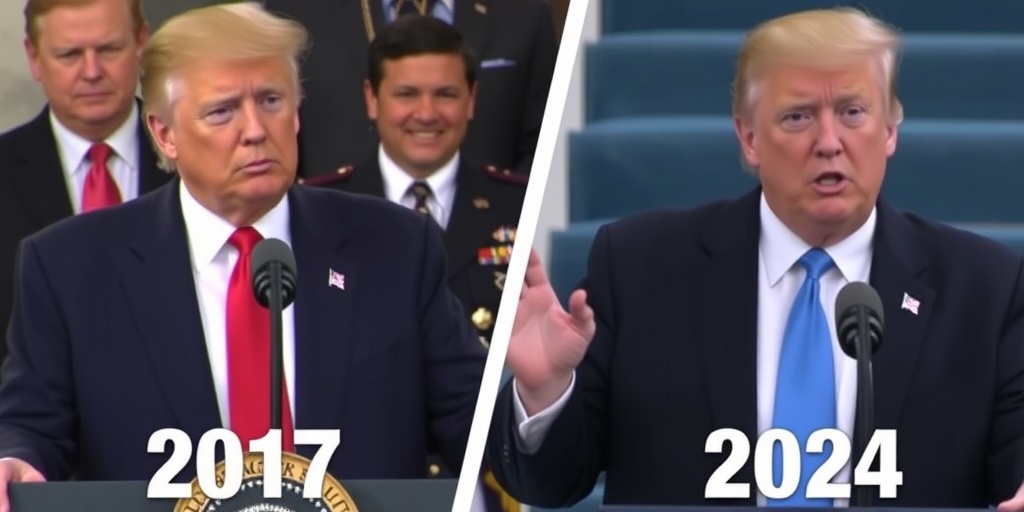Now Reading: Comparing Trump’s Inaugural Addresses: 2017 vs. 2025
-
01
Comparing Trump’s Inaugural Addresses: 2017 vs. 2025
Comparing Trump’s Inaugural Addresses: 2017 vs. 2025

Title: Analyzing the Dark Undertones of President Trump’s Inaugural Address
In a striking display of rhetoric that some observers claim hearkens back to the tone of his previous address, President Donald Trump delivered his inaugural address on a recent Monday that many described as even darker than his notorious speech eight years ago. Michael D. Shear, a seasoned White House correspondent for The New York Times, offers an insightful analysis of the themes and implications present in Trump’s latest speech, which paints a complex picture of America’s current landscape.
Trump’s inaugural address was characterized by a stark portrayal of the nation, emphasizing division, decay, and an overall sense of distress that resonated powerfully with certain segments of the American population. Eight years prior, his inaugural address famously introduced the phrase “American carnage,” an expression that encapsulated his vision of a troubled nation rife with violence, economic despair, and social disintegration. However, in what many are calling a continuation or even escalation of this motif, Trump’s latest address layered additional grim narratives over an already bleak foundation.
Shear’s analysis underscores Trump’s tendency to cast the American experience in a negative light, focusing not just on societal problems but on a perceived existential threat to the nation’s values and identity. During the address, Trump reiterated his commitment to addressing crime, economic inequality, and the erosion of community norms, framing these issues as not just challenges to be faced but as fundamental threats to the very fabric of the nation.
A notable aspect of the speech was Trump’s invocation of the “forgotten men and women” of America—an archetype he often references to tap into populist sentiments. This demographic was portrayed as victims of failed policies and societal neglect, thus galvanizing a collective grievance that has underpinned much of his political rhetoric. By aligning himself with this group, Trump positioned his administration as a protector of their interests, promising to restore their dignity and place in society.
However, critics argue that framing the narrative in such a dark manner risks deepening the existing divides within the nation. Shear points out that Trump’s language could exacerbate tensions by painting a binary picture of good versus evil, which may alienate those who do not share his worldview. The speech lacked the conciliatory tone often expected from an inaugural address, opting instead for a rallying cry that emphasizes conflict and challenge, rather than unity and hope.
Moreover, the address was marked by an emphasis on nationalism and a protectionist stance. Trump’s remarks about America’s engagement with the world were drenched in skepticism, suggesting that previous administrations had betrayed the nation’s interests. This focus on “America First” signals a regression from previous bipartisan efforts toward global cooperation, which could have long-term implications both domestically and abroad.
Despite the bleak outlook presented, Trump’s address simultaneously contained elements of triumphalism. Shear notes that there were flashes of optimism woven into his narrative, as the President spoke of a resurgence of American strength and resilience. These moments served to remind listeners that amid the chaos, there exists a potential for renewal—a sentiment that, while potent, is starkly juxtaposed against the overall tone of despair.
Critics of Trump’s approach contend that this style of addressing the nation perpetuates a cycle of fear and anger, potentially undermining the fabric of a cohesive society. The effects of such rhetoric, they argue, may lead to increased polarization and hinder constructive dialogue necessary for healing and progress.
In conclusion, President Trump’s recent inaugural address stands as a provocative moment in American political discourse, revealing deep divisions and the complexities of his vision for the nation. As Michael D. Shear’s analysis indicates, the darker tone resonates with supporters while potentially alienating others. As the nation moves forward, the implications of this address will likely be scrutinized, raising questions about the path ahead for a country grappling with its identity and future. Whether this speech will serve as a rallying point for his base or deepen fractures within the larger American society remains to be seen.
Stay Informed With the Latest & Most Important News
Previous Post
Next Post
-
 01New technology breakthrough has everyone talking right now
01New technology breakthrough has everyone talking right now -
 02Unbelievable life hack everyone needs to try today
02Unbelievable life hack everyone needs to try today -
 03Fascinating discovery found buried deep beneath the ocean
03Fascinating discovery found buried deep beneath the ocean -
 04Man invents genius device that solves everyday problems
04Man invents genius device that solves everyday problems -
 05Shocking discovery that changes what we know forever
05Shocking discovery that changes what we know forever -
 06Internet goes wild over celebrity’s unexpected fashion choice
06Internet goes wild over celebrity’s unexpected fashion choice -
 07Rare animal sighting stuns scientists and wildlife lovers
07Rare animal sighting stuns scientists and wildlife lovers





















